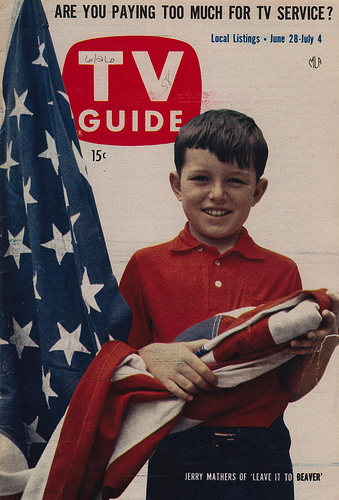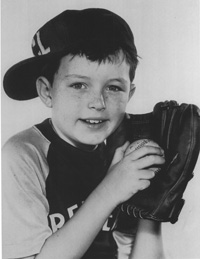My 1958 TV Guide interview
Here is my article from the 1958 issue of TV Guide!…
TV Guide, June 28th, 1958
Master Jerry Mathers who is 65 pounds dripping wet and is by his own admission, known a heckuva lot better as TV’s Beaver Theodore Cleaver, recently submitted to an interview on what it’s like to be 10 years old and the star of your own successful television show. The show of course is CBS’s Leave It To Beaver, a lively chronicle of doings in the slingshot set of the season’s surprise hit, but incidentally it moves to ABC next fall. The interview took place in the producer’s office.
The star showed up bright eyed, mother in tow, wearing powder blue cords, a spanking new leather motorcycle jacket with ivy league belt, two blue eyes, and a smile wrapped several times around his face. He stashed his mother outside the door and plunked himself down in the producer’s chair. Acting he said is, “OK for kids, real keen, it really is”, but he added, beginning to bounce, “when I grow up I want to be something really good – a court lawyer who tries murders and stuff like that.”
While we were busy ruminating on the happy fact that the real life Beaver was all boy and a yard wide, Jerry explained his plan to be a, “private eye first, ‘cause to be a lawyer, my Dad says you gotta know about the police and what they’re doing.”
Just then a press agent produced a note filling in some highlights of Mather’s career. Jerry was born June 2, 1948, in Soux City, Iowa. Jerry’s father came to California shortly thereafter to become special counselor at Birmingham General High School in the San Fernando Valley. Jerry’s career began at the age of two when his mother took to heart a well intention sales lady’s suggestion that he ought to be in television. Presto, he landed on the Ed Wynn Show. This led to more television and later to movies. The most recent being Alfred Hitchcock’s The Trouble with Harry and Bob Hope’s The Seven Little Boys. “’Course, I don’t remember much about that first show,” the Beaver was saying, “I did that when I was little.”
Beaver in real life has a sister named Susie who is 7, a brother named Jimmy who is 3, a cat named Tuffy and a dog named Ron Ton Ton. “We all watch The Beaver show together,” he explained. “My little brother gets up and marches around the room pointing at the TV set and yelling ‘Beaver Beaver Beaver’.” Sometimes he’s a pest. “My dog, his great great great great grandfather was Rin Tin Tin. Honest! And oh, yea, I got an ant farm too, you know, one of those glass things where you can watch the ants dig tunnels.”
We resisted the temptation to ask how the ants enjoyed the show and settled for a discussion on parents and little sisters. Beaver, most of his friends now call him Beaver instead of Jerry, said he could give almost unqualified approval of his parents. “Mine are real swell, really.” And of sisters? “Most of the time, except when they’re being pests and wanting to do something you don’t want to do.” On television, Beaver isn’t supposed to like girls but he, Jerry Mathers does. What girls? “I don’t think I’m going to tell you.
Jerry explained how he was an expert pitcher, little league aspirant, cub scout, and crack shot with a trusty air rifle. “Yesterday, I shot four nines and a bulls eye. And oh yeah, I’m a rockhound. That means I collect rocks” “What kind?” “Oh, different kinds. Say, if you see any, will you bring some back for me, huh?”
For some reason, this lead into a discussion of dramatic art, Beaver variety. The Beaver who reportedly earns a weekly $500 for said art, said he was never scared before a camera. “Mr. Tokar, he’s our director, shows me how to do it. If it’s a big dramatic scene, if it’s not a big dramatic scene – he shows me how to do it anyways.” Crying for the camera is duck soup to a man of the Beaver’s resources.
“I just think of something sad like what Beaver would be thinking of, like losing a dog if Ron Ton Ton was sick or something, then I can cry real good.” As for those scrapes the fictional Beaver keeps getting into, well, the real life Beaver confesses to a few doubts. Confidentially he says, squinting and bouncing up and down three times, “I don’t think any one body could get into all those messes. Six or seven maybe, but not 40 or 50 or a 100 messes. Then you take Tony Dow. He plays the Beaver’s older brother, Wally. He’s not really realistic. A bigger boy wouldn’t be so dumb as he is in our script. I mean, a bigger boy would find a way out of all those messes that works.”
“Of course,” he added reflectively, “most boys do get caught.” Beaver and 13 year old Tony Dow get along fine on the set in the studio school where they’re classmates. They read each other’s passages from the Beaver’s favorite book, Rip Van Winkle. “Everybody must read it,” the Beaver said. “It’s very educational. Real swell. Really.”
The Beaver rises at 6:30 a.m., rides in to the studio from Canoga Park, puts in a full day and gets home at 6:45 p.m. “I eat, study my lines, and it’s time for bed.” As for school, “Generally, well, adding is OK. I don’t like division though. Spelling depends on how much time they give you.”
On weekends his dad frequently takes him out shooting with his air rifle or simply down to the Rifleman’s Association shooting range for a little target practice. His favorite Beaver shows he thinks are the episodes called The Haircut, Captain Jack, and Brotherly Love. We made careful note of this as being particularly significant until the Beaver went on to amend the list with 25 others that have been shot thus far as also being his favorites. By the end of that recital he was breathless and so were we.



